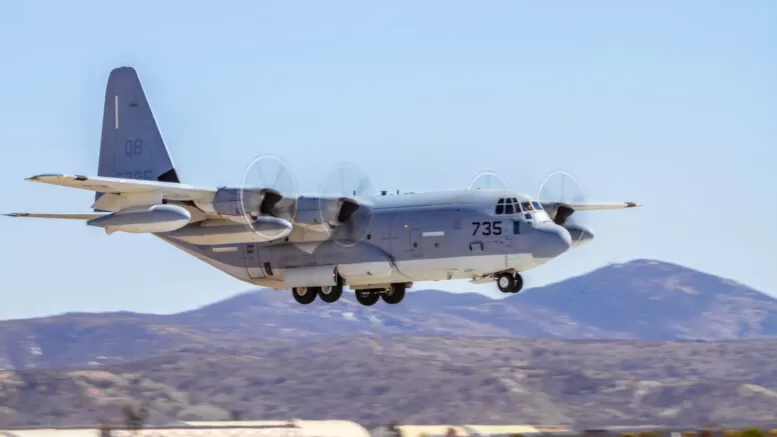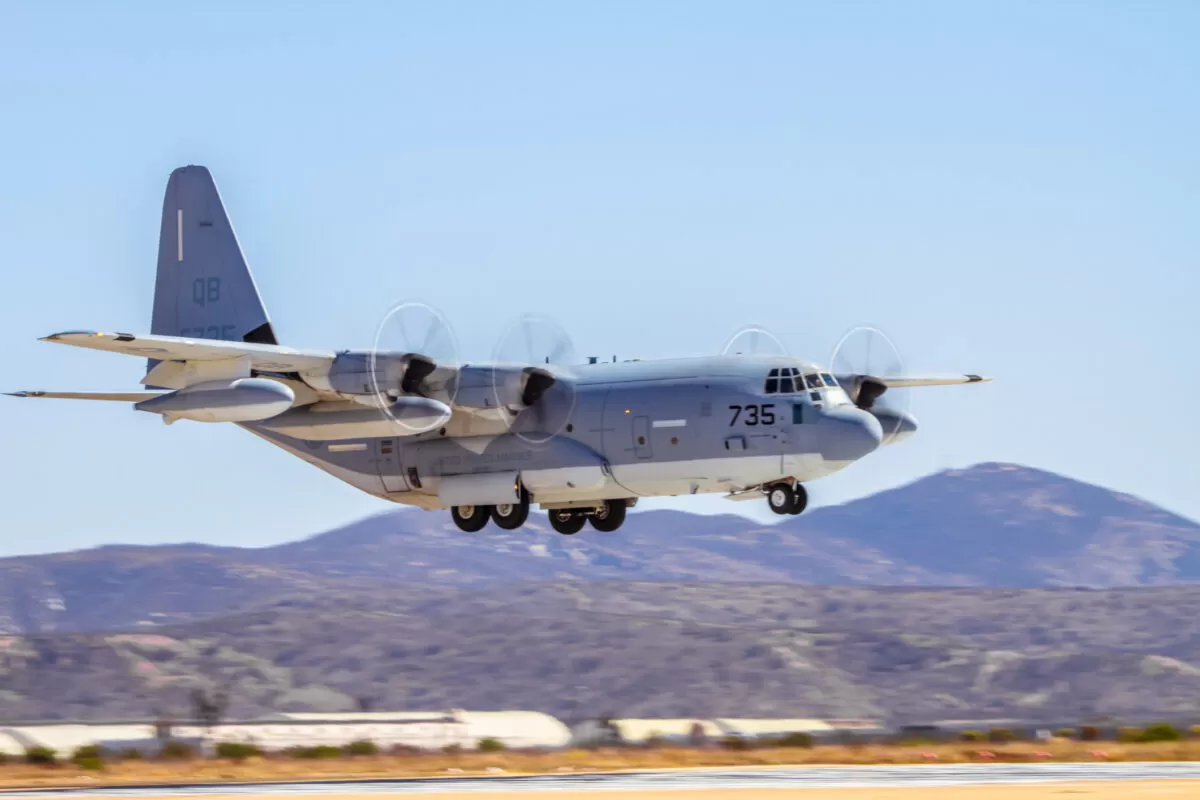The C130J Super Hercules has earned a reputation as one of the most versatile and reliable aircraft in the world.
Known for its remarkable ability to perform a wide range of missions, from military operations to humanitarian relief, the C130J is truly the backbone of modern air mobility. Whether it’s delivering supplies to remote regions, evacuating casualties from the battlefield, or performing airdrops in challenging conditions, this powerhouse has proven time and again that it can adapt to any scenario.
At airshows like Wings Over Camarillo, the C130J often steals the spotlight with its impressive aerial maneuvers, showcasing its agility despite its large size. Behind the incredible stunts, however, lies a deeply functional aircraft that is indispensable to military forces, emergency responders, and even disaster relief agencies around the globe.
In this blog, we will take a closer look at the C130J Super Hercules—exploring its history, technological innovations, and the crucial role it plays in modern air mobility.
What Makes the C130J Super Hercules a Critical Asset in Modern Air Mobility?
The C130J Super Hercules stands as a testament to the evolution of tactical air mobility, blending unmatched versatility with powerful performance capabilities.
What sets the C130J apart from other aircraft is its ability to perform a diverse range of missions, each requiring different skill sets and equipment. Unlike many aircraft that specialize in one type of task, the C130J thrives in multiple roles, making it an indispensable asset for both military and humanitarian operations.
At its core, the C130J is a strategic and tactical transport aircraft, capable of carrying heavy payloads over long distances while operating from short, austere airstrips. This flexibility allows it to reach areas that would otherwise be inaccessible to larger cargo planes or helicopters.
Whether flying into hostile environments to deliver supplies or conducting airdrops behind enemy lines, the C130J has the ability to quickly and efficiently deploy personnel, equipment, and vital resources.
Evolution from the Original Hercules to the C130J
The C130J Super Hercules is the latest and most advanced model in a storied aircraft lineage that began over six decades ago.
The original C-130 Hercules took its first flight in 1954, born out of a need for a rugged, reliable transport aircraft capable of operating under extreme conditions. What followed was one of the longest production runs in aviation history—a testament to the platform’s adaptability, durability, and enduring strategic value.
The C-130A and C-130E
Early versions of the Hercules, such as the C-130A and C-130E, were revolutionary in their own right, setting benchmarks in airlift performance. They introduced a high-wing design for better ground clearance and cargo handling, and a rear-loading ramp that allowed for rapid deployment of vehicles and equipment.
Over the years, each variant added improvements in range, payload capacity, avionics, and safety systems, steadily evolving to meet the changing demands of the modern battlefield.
Modernization of the C130J Super Hercules
The leap to the C130J Super Hercules, however, was more than just an incremental upgrade. It was a complete modernization of the platform.
Equipped with Rolls-Royce AE 2100D3 turboprop engines, the C130J delivers greater speed, range, and fuel efficiency than any of its predecessors. It features an all-glass digital cockpit, eliminating the need for a flight engineer or navigator, and streamlining flight operations through automation and advanced avionics. The airframe, while similar in silhouette, has been re-engineered for improved aerodynamic performance and mission flexibility.
This transformation did not come at the expense of reliability. In fact, the C130J builds upon the ruggedness that made the Hercules a legend, while adding the technological sophistication demanded by modern military operations. From flying into hostile territory with electronic countermeasures to making pinpoint airdrops with GPS-guided systems, the C130J represents a new era of precision and capability.
In essence, the evolution of the Hercules from its early forms to the current C130J is a case study in strategic innovation—balancing tradition with transformation. While the aircraft retains the soul of the original Hercules, its modern enhancements ensure that it remains a cornerstone of global air mobility for decades to come.
How the C130J Super Hercules Performs in Combat and Humanitarian Missions
The C130J Super Hercules thrives where the demands are greatest—on the front lines of combat and in the heart of humanitarian crises.
Its ability to adapt to vastly different environments and mission types makes it a force multiplier in both warzones and disaster-stricken regions. Few aircraft are asked to do more under such pressure, and fewer still consistently deliver at the level of the C130J.
In the Military
In combat operations, the C130J is a workhorse. It executes critical tasks such as tactical airlift, paratrooper deployment, and equipment transport under fire.
Thanks to its short takeoff and landing (STOL) capabilities, it can deliver troops and supplies to unimproved or damaged airstrips close to conflict zones—something heavier aircraft simply cannot do. With integrated self-protection systems and electronic countermeasures, it can enter high-risk areas with minimized exposure to threats.
The C130J also supports special operations, often flying low-level missions at night to insert elite units behind enemy lines.
Humanitarian Support
Beyond the battlefield, the C130J serves as a lifeline during humanitarian crises.
Whether responding to an earthquake, tsunami, or refugee emergency, it has the ability to deliver life-saving aid with unmatched speed and reach. Its cavernous cargo bay can be configured for medical evacuation, temporary shelters, or food and water distribution.
During the COVID-19 pandemic and other global emergencies, the C130J was mobilized to transport medical supplies and even act as an airborne hospital in certain configurations.
Reliability and Reconfigurability
One of the aircraft’s greatest strengths lies in its rapid reconfigurability.
It can transition from hauling supplies to carrying patients in a matter of hours. This modularity means that when lives are on the line—whether due to war or natural disaster—the C130J can adapt and respond with efficiency and reliability. It has operated in the most inhospitable environments on Earth: arctic runways, desert strips, mountainous terrain, and flood-ravaged fields.
Whether flying into a conflict zone under threat or touching down in a devastated village with relief supplies, the C130J Super Hercules performs with a precision and resilience that few aircraft can match.
Its dual role in both war and peace not only highlights its engineering excellence, but also its enduring humanity. It is as much a symbol of strength as it is a beacon of hope.
The C130J Super Hercules at Wings Over Camarillo
The C130J Super Hercules never fails to impress at airshows like Wings Over Camarillo. Towering in size and unmatched in versatility, this aircraft is a crowd favorite. It is also not just another display model; it is a demonstration of modern airlift excellence in motion.
For those who want to see the C130J Super Hercules as a static display, there is no better place than Wings Over Camarillo. There, you will not only witness this iconic aircraft—you will feel its story come to life. The C130J is not just an airlifter. It is a legacy in motion.
Conclusion
From its first mission to its latest innovation, the C130J Super Hercules has earned its place as the backbone of modern air mobility.
Its ability to operate across a broad spectrum of environments—from front-line combat zones to natural disaster response—proves its unmatched versatility and enduring value. Whether flying into danger or delivering hope, it consistently rises to the mission.
What sets the C130J apart is not just its advanced engineering, but its ability to adapt—quickly, efficiently, and reliably. It has evolved from a legacy aircraft into a next-generation workhorse without losing the rugged spirit that made the Hercules family legendary.
Its presence in global operations, and on the airshow circuit, reminds us that some machines are built not just to last, but to lead.
Ready to Soar with Us?


